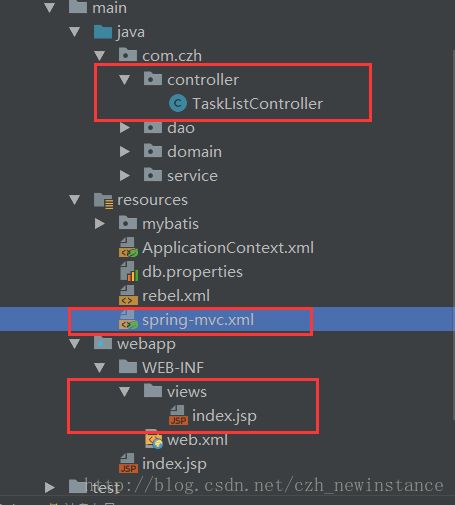- 00. 这里整理了最全的爬虫框架(Java + Python)
有一只柴犬
爬虫系列爬虫javapython
目录1、前言2、什么是网络爬虫3、常见的爬虫框架3.1、java框架3.1.1、WebMagic3.1.2、Jsoup3.1.3、HttpClient3.1.4、Crawler4j3.1.5、HtmlUnit3.1.6、Selenium3.2、Python框架3.2.1、Scrapy3.2.2、BeautifulSoup+Requests3.2.3、Selenium3.2.4、PyQuery3.2
- springboot宠物咖啡馆平台的设计与实现
然然学长
springboot宠物java后端intellij-idea开发语言
运行环境环境说明:开发语言:java框架:springboot,vueJDK版本:JDK1.8数据库:mysql5.7+(推荐5.7,8.0也可以)数据库工具:Navicat11+开发软件:idea/eclipse(推荐idea)Maven包:Maven3.3.9+系统详细实现管理员模块的实现用户信息管理基于SpringBoot的宠物咖啡馆平台的设计与实现的系统管理员可以管理用户,可以对用户信息添
- springboot旅游管理系统的设计与实现
然然学长
springboot旅游java毕业设计后端
运行环境环境说明:开发语言:java框架:springboot,vueJDK版本:JDK1.8数据库:mysql5.7+(推荐5.7,8.0也可以)数据库工具:Navicat11+开发软件:idea/eclipse(推荐idea)Maven包:Maven3.3.9+系统实现登录模块的实现用户要想进入本系统,必须通过正确的用户名和密码,选择登录类型进行登录操作,在登录时系统会以用户名、密码和登录类型
- Java框架-mybatis-基础
KeepStruggling
mybatisJava
1.概念1.1概念引入框架(Framework)是整个或部分系统的可重用设计,表现为一组抽象构件及构件实例间交互的方法。或者说是可被应用开发者定制的应用骨架。框架的优点:框架已经实现了一些功能,使用时不需重复实现这些功能,提高开发效率;使用框架后,我们软件的架构更加稳定、开发流程必须按照框架约定进行,而优秀的框架是所有开发人员都熟悉的,任何人进入项目团队后可以更快适应开发,同时框架良好的扩展性更易
- 在Spring Boot中实现请求IP白名单拦截
missterzy
JAVA框架springboottcp/ipjava
在Web应用中,通过IP白名单机制,我们可以允许特定的IP地址访问应用,而阻止其他IP地址。这种机制在保护管理后台、API接口等敏感资源时尤为有效。SpringBoot作为一个流行的Java框架,提供了丰富的配置和扩展能力,使得我们可以方便地实现IP白名单功能。什么是IP白名单IP白名单是一种访问控制机制,通过维护一个允许访问的IP地址列表,只有列表中的IP地址才可以访问特定资源。相比之下,黑名单
- Java框架ssm之MyBatis
很遗憾不是吗_
mybatisjava数据库
MyBatis-概述MyBatis框架是一种可以替代原生态的JDBC,单纯的只使用JDBC话会使项目代码变得冗余,耦合度高,编写sql语句复杂,显得比较麻烦,开发人员为了避免这种问题和提高开发效率提供了相对应的框架支持—MyBatis。MyBatis框架是一种持久层框架,支持自定义Sql语句、存储过程甚至是高级映射。MyBatis基本上避免了原生态的JDBC的复杂代码,包括一些设置Sql语句的参数
- 七种常用设计模式
豪宇刘
设计模式java开发语言
本章学习面向对象的一些高级应用——设计模式。在学习过程中会了解到一些软件设计思想和原则,作为一名软件开发者,不仅要能开发高质量的代码,还要能够做出优秀的设计。设计模式被广泛运用在Java框架技术中,学习设计模式对于理解框架的工作原理会有所帮助。学习方法:设计模式虽有很多种,但总是可以从解锅台、提高复用性这些方向来理解。首先要明确每种设计模式的使用场景,明确其要解决的问题,进而理解其解决该问题的思路
- 全面解读 Spring 和 Spring MVC 常用注解
胡耀超
Springjava面试常见问题springmvcjava
Spring是一个功能强大的Java框架,用于构建企业级应用程序。SpringMVC是Spring框架的一部分,专注于构建基于Web的应用程序。为了有效地使用这些框架,了解常用注解及其应用场景至关重要。1.总体总结Spring框架和SpringMVC提供了大量注解,用于简化配置、依赖注入、面向切面编程(AOP)等任务。下表概述了一些常见的注解,按类别进行划分,包括核心Spring注解和Spring
- 初学者指南:Spring Boot入门
努力编程的阿伟
springboot后端java
引言在当今快速发展的软件开发领域,SpringBoot已经成为了构建现代Java应用程序的首选框架之一。它以其简洁、易用和强大的特性,帮助开发者快速搭建起基于Spring的应用程序。如果你是Java开发新手,或者正在寻找一种更高效的开发方式,那么SpringBoot无疑是一个值得学习的技术。SpringBoot是什么?SpringBoot是一个开源的Java框架,由Pivotal团队(现为VMwa
- 【Java】Spring Boot 教程
Ustinian_310
javaspringboot开发语言
SpringBoot入门教程SpringBoot介绍SpringBoot是一个开源的Java框架,旨在简化Spring应用的创建和部署过程。它提供了一种快速和简便的方式来设置、配置和运行新的Spring应用程序,通过“约定优于配置”的原则,减少了传统Spring应用中大量的XML配置,使得开发者能够更加专注于业务逻辑的实现,从而加速开发周期,并轻松创建独立运行的、生产级别的基于Spring的应用程
- 学会辨识「漏洞炒作」你就比别人强!
强哥叨逼叨
点击关注强哥,查看更多精彩文章呀哈喽,大家好,我是强哥。昨天,最受欢迎的开源轻量级Java框架Spring被曝存在高危的RCE(远程控制设备)零日漏洞,北京大学计算中心、外媒praetorian、bleepingcomputer等站点对该漏洞进行了报道。炒作强哥也看到了很多媒体疯狂报道此事,根据网上疯传的介绍,该RCE漏洞源于Spring框架核心的SerializationUtils#dseria
- Redisson
sp_wxf
java
Redisson1什么是Redisson2.SpringBoot整合Redisson1什么是RedissonRedisson是一个基于Redis的java框架,用于简化Redis的操作.它提供了丰富的功能,包括:分布式集合、分布式对象、分布式锁、分布式调度器等等2.SpringBoot整合Redisson步骤一:添加依赖org.redissonredisson-spring-boot-starte
- springboot/ssm工作量统计系统Java工作记录可视化管理系统web
kirito学长-Java
javaspringboot后端
springboot/ssm工作量统计系统Java工作记录可视化管理系统web基于springboot(可改ssm)+vue项目开发语言:Java框架:springboot/可改ssm+vueJDK版本:JDK1.8(或11)服务器:tomcat数据库:mysql5.7(或8.0)数据库工具:Navicat/sqlyog开发软件:eclipse//idea依赖管理包:Maven如需了解更多代码细节
- Springboot企业级开发--1.开发入门
yueqingll
Springboot企业级开发springboot后端java
目录目录一.SpringBoot的主要特点和优势包括:二.SpringBoot的核心功能可以归纳为以下几点:三.Springboot是如何解决问题?SpringBoot是一个开源的Java框架,其设计目标是为了简化新Spring应用的初始搭建以及开发过程。它不是对Spring框架功能上的替代或补充,而是提供了一种快速、简洁的方式来创建独立运行、生产级别的基于Spring的应用程序。一.Spring
- springboot/ssm文献搜索系统Java文献信息在线下载系统小说下载系统web
Java学长-kirito
javaspringboot后端
springboot/ssm文献搜索系统Java文献信息在线下载系统小说下载系统web基于springboot(可改ssm)+vue项目开发语言:Java框架:springboot/可改ssm+vueJDK版本:JDK1.8(或11)服务器:tomcat数据库:mysql5.7(或8.0)数据库工具:Navicat/sqlyog开发软件:eclipse//idea依赖管理包:Maven如需了解更多
- [花店]网上花店微信小程序的设计与实现
Selina .a
微信小程序小程序springboot微信前端
文末获取源码开发语言:Java框架:SpringBootJDK版本:JDK1.8数据库:mysql5.7开发软件:eclipse/myeclipse/ideaMaven包:Maven3.5.4小程序框架:uniapp小程序开发软件:HBuilderX小程序运行软件:微信开发者目录目录前言系统展示管理员功能模块的实现鲜花列表公告信息管理公告类型管理用户功能介绍鲜花管理公告管理代码实现登录功能实现代码
- 基于微信小程序的居民健康监测的设计与实现
Selina .a
微信小程序小程序springboot美食学习
文末获取源码开发语言:Java框架:SpringBootJDK版本:JDK1.8数据库:mysql5.7开发软件:eclipse/myeclipse/ideaMaven包:Maven3.5.4小程序框架:uniapp小程序开发软件:HBuilderX小程序运行软件:微信开发者目录目录前言系统展示用户信息管理健康科普管理公告类型管理论坛信息管理代码实现登录功能实现代码注册功能实现代码密码重置功能实现
- 基于微信的铁路订票平台小程序的设计与实现
Selina .a
微信小程序springboot微信小程序前端
文末获取源码开发语言:Java框架:SpringBootJDK版本:JDK1.8数据库:mysql5.7开发软件:eclipse/myeclipse/ideaMaven包:Maven3.5.4小程序框架:uniapp小程序开发软件:HBuilderX小程序运行软件:微信开发者目录目录前言系统展示用户信息管理车次信息管理公告信息管理论坛信息管理代码实现登录功能实现代码注册功能实现代码密码重置功能实现
- 基于微信小程序的美食推荐系统的设计与实现
Selina .a
微信小程序美食小程序springboot学习uni-appjava
文末获取源码开发语言:Java框架:SpringBootJDK版本:JDK1.8数据库:mysql5.7开发软件:eclipse/myeclipse/ideaMaven包:Maven3.5.4小程序框架:uniapp小程序开发软件:HBuilderX小程序运行软件:微信开发者目录目录前言系统展示用户信息管理水果信息管理水果类型管理论坛信息管理代码实现登录功能实现代码注册功能实现代码密码重置功能实现
- java/jsp/ssm汉服文化宣传网站【2024年毕设】
扬基程序
java课程设计开发语言
本系统带文档lw万字以上文末可领取本课题的JAVA源码参考开发环境开发语言:Java框架:ssm技术:ssm+jspJDK版本:JDK1.8服务器:tomcat7数据库:mysql5.7或8.0数据库工具:Navicat11开发软件:eclipse/myeclipse/ideaMaven包:Maven3.3.9浏览器:建议谷歌浏览器或edge功能模块系统界面2023-2024年成品除了以上作品下面
- java/jsp/ssm影视论坛交流网站【2024年毕设】
灵军程序设计
java课程设计开发语言
本系统带文档lw万字以上文末可领取本课题的JAVA源码参考开发环境开发语言:Java框架:ssm技术:ssm+jspJDK版本:JDK1.8服务器:tomcat7数据库:mysql5.7或8.0数据库工具:Navicat11开发软件:eclipse/myeclipse/ideaMaven包:Maven3.3.9浏览器:建议谷歌浏览器或edge功能模块系统界面2023-2024年成品除了以上作品下面
- springboot/ssm甘肃旅游服务平台Java在线旅游规划管理系统
kirito学长-Java
javaspringboot旅游
springboot/ssm甘肃旅游服务平台Java在线旅游规划管理系统开发语言:Java框架:springboot(可改ssm)+vueJDK版本:JDK1.8(或11)服务器:tomcat数据库:mysql5.7(或8.0)数据库工具:Navicat开发软件:eclipse//idea依赖管理包:Maven如需了解更多代码细节或修改代码功能界面,本人都能提供技术支持。(声音嘎嘎好听喔!)祝你早
- springboot/ssm公司进销存系统Java商品销售出入库系统
kirito学长-Java
javaspringboot开发语言
springboot/ssm公司进销存系统Java商品销售出入库系统开发语言:Java框架:springboot(可改ssm)+vueJDK版本:JDK1.8(或11)服务器:tomcat数据库:mysql5.7(或8.0)数据库工具:Navicat开发软件:eclipse//idea依赖管理包:Maven如需了解更多代码细节或修改代码功能界面,本人都能提供技术支持。(声音嘎嘎好听喔!)祝你早日找
- springboot/ssm甘肃旅游服务平台Java在线旅游规划管理系统
kirito学长-Java
javaspringboot旅游
springboot/ssm甘肃旅游服务平台Java在线旅游规划管理系统开发语言:Java框架:springboot(可改ssm)+vueJDK版本:JDK1.8(或11)服务器:tomcat数据库:mysql5.7(或8.0)数据库工具:Navicat开发软件:eclipse//idea依赖管理包:Maven如需了解更多代码细节或修改代码功能界面,本人都能提供技术支持。(声音嘎嘎好听喔!)祝你早
- springboot/ssm高校汉服租赁网站Java传统汉服租赁交流论坛系统
kirito学长-Java
javaspringboot开发语言
springboot/ssm高校汉服租赁网站Java传统汉服租赁交流论坛系统开发语言:Java框架:springboot(可改ssm)+vueJDK版本:JDK1.8(或11)服务器:tomcat数据库:mysql5.7(或8.0)数据库工具:Navicat开发软件:eclipse//idea依赖管理包:Maven如需了解更多代码细节或修改代码功能界面,本人都能提供技术支持。(声音嘎嘎好听喔!)祝
- Springboot/java/node/python/php基于微信小程序的二手商城【2024年毕设】
阿诚程序
javaspringboot微信小程序
本系统带文档lw万字以上文末可领取本课题的JAVA源码参考开发环境开发语言:Java框架:Springboot技术:springboot+vueJDK版本:JDK1.8服务器:tomcat7数据库:mysql5.7或8.0数据库工具:Navicat11开发软件:eclipse/myeclipse/ideaMaven包:Maven3.3.9浏览器:建议谷歌浏览器或edge功能模块系统界面2023-2
- Springboot/java/node/python/php基于微信小程序的社交系统【2024年毕设】
灵军程序设计
javaspringboot微信小程序
本系统带文档lw万字以上文末可领取本课题的JAVA源码参考开发环境开发语言:Java框架:Springboot技术:springboot+vueJDK版本:JDK1.8服务器:tomcat7数据库:mysql5.7或8.0数据库工具:Navicat11开发软件:eclipse/myeclipse/ideaMaven包:Maven3.3.9浏览器:建议谷歌浏览器或edge功能模块系统界面2023-2
- Springboot/java/node/python/php基于微信支付的在线打印微信小程序【2024年毕设】
灵军程序设计
javaspringboot微信小程序
本系统带文档lw万字以上文末可领取本课题的JAVA源码参考开发环境开发语言:Java框架:Springboot技术:springboot+vueJDK版本:JDK1.8服务器:tomcat7数据库:mysql5.7或8.0数据库工具:Navicat11开发软件:eclipse/myeclipse/ideaMaven包:Maven3.3.9浏览器:建议谷歌浏览器或edge功能模块系统界面2023-2
- Springboot/java/node/python/php基于微信小程序的奶茶商城【2024年毕设】
扬基程序
javaspringboot微信小程序
本系统带文档lw万字以上文末可领取本课题的JAVA源码参考开发环境开发语言:Java框架:Springboot技术:springboot+vueJDK版本:JDK1.8服务器:tomcat7数据库:mysql5.7或8.0数据库工具:Navicat11开发软件:eclipse/myeclipse/ideaMaven包:Maven3.3.9浏览器:建议谷歌浏览器或edge功能模块系统界面2023-2
- java/php/net/python美容美发店会员管理系统
星云计算机毕设程序源码
java开发语言
本系统带文档lw万字以上文末可领取本课题的JAVA源码参考开发环境开发语言:Java框架:ssm技术:JSPJDK版本:JDK1.8服务器:tomcat7数据库:mysql5.7(一定要5.7版本)数据库工具:Navicat11开发软件:eclipse/myeclipse/ideaMaven包:Maven3.3.9浏览器:建议谷歌浏览器功能模块模块包括主界面,首页、个人中心、员工管理、散客管理、会
- iOS http封装
374016526
ios服务器交互http网络请求
程序开发避免不了与服务器的交互,这里打包了一个自己写的http交互库。希望可以帮到大家。
内置一个basehttp,当我们创建自己的service可以继承实现。
KuroAppBaseHttp *baseHttp = [[KuroAppBaseHttp alloc] init];
[baseHttp setDelegate:self];
[baseHttp
- lolcat :一个在 Linux 终端中输出彩虹特效的命令行工具
brotherlamp
linuxlinux教程linux视频linux自学linux资料
那些相信 Linux 命令行是单调无聊且没有任何乐趣的人们,你们错了,这里有一些有关 Linux 的文章,它们展示着 Linux 是如何的有趣和“淘气” 。
在本文中,我将讨论一个名为“lolcat”的小工具 – 它可以在终端中生成彩虹般的颜色。
何为 lolcat ?
Lolcat 是一个针对 Linux,BSD 和 OSX 平台的工具,它类似于 cat 命令,并为 cat
- MongoDB索引管理(1)——[九]
eksliang
mongodbMongoDB管理索引
转载请出自出处:http://eksliang.iteye.com/blog/2178427 一、概述
数据库的索引与书籍的索引类似,有了索引就不需要翻转整本书。数据库的索引跟这个原理一样,首先在索引中找,在索引中找到条目以后,就可以直接跳转到目标文档的位置,从而使查询速度提高几个数据量级。
不使用索引的查询称
- Informatica参数及变量
18289753290
Informatica参数变量
下面是本人通俗的理解,如有不对之处,希望指正 info参数的设置:在info中用到的参数都在server的专门的配置文件中(最好以parma)结尾 下面的GLOBAl就是全局的,$开头的是系统级变量,$$开头的变量是自定义变量。如果是在session中或者mapping中用到的变量就是局部变量,那就把global换成对应的session或者mapping名字。
[GLOBAL] $Par
- python 解析unicode字符串为utf8编码字符串
酷的飞上天空
unicode
php返回的json字符串如果包含中文,则会被转换成\uxx格式的unicode编码字符串返回。
在浏览器中能正常识别这种编码,但是后台程序却不能识别,直接输出显示的是\uxx的字符,并未进行转码。
转换方式如下
>>> import json
>>> q = '{"text":"\u4
- Hibernate的总结
永夜-极光
Hibernate
1.hibernate的作用,简化对数据库的编码,使开发人员不必再与复杂的sql语句打交道
做项目大部分都需要用JAVA来链接数据库,比如你要做一个会员注册的 页面,那么 获取到用户填写的 基本信后,你要把这些基本信息存入数据库对应的表中,不用hibernate还有mybatis之类的框架,都不用的话就得用JDBC,也就是JAVA自己的,用这个东西你要写很多的代码,比如保存注册信
- SyntaxError: Non-UTF-8 code starting with '\xc4'
随便小屋
python
刚开始看一下Python语言,传说听强大的,但我感觉还是没Java强吧!
写Hello World的时候就遇到一个问题,在Eclipse中写的,代码如下
'''
Created on 2014年10月27日
@author: Logic
'''
print("Hello World!");
运行结果
SyntaxError: Non-UTF-8
- 学会敬酒礼仪 不做酒席菜鸟
aijuans
菜鸟
俗话说,酒是越喝越厚,但在酒桌上也有很多学问讲究,以下总结了一些酒桌上的你不得不注意的小细节。
细节一:领导相互喝完才轮到自己敬酒。敬酒一定要站起来,双手举杯。
细节二:可以多人敬一人,决不可一人敬多人,除非你是领导。
细节三:自己敬别人,如果不碰杯,自己喝多少可视乎情况而定,比如对方酒量,对方喝酒态度,切不可比对方喝得少,要知道是自己敬人。
细节四:自己敬别人,如果碰杯,一
- 《创新者的基因》读书笔记
aoyouzi
读书笔记《创新者的基因》
创新者的基因
创新者的“基因”,即最具创意的企业家具备的五种“发现技能”:联想,观察,实验,发问,建立人脉。
第一部分破坏性创新,从你开始
第一章破坏性创新者的基因
如何获得启示:
发现以下的因素起到了催化剂的作用:(1) -个挑战现状的问题;(2)对某项技术、某个公司或顾客的观察;(3) -次尝试新鲜事物的经验或实验;(4)与某人进行了一次交谈,为他点醒
- 表单验证技术
百合不是茶
JavaScriptDOM对象String对象事件
js最主要的功能就是验证表单,下面是我对表单验证的一些理解,贴出来与大家交流交流 ,数显我们要知道表单验证需要的技术点, String对象,事件,函数
一:String对象;通常是对字符串的操作;
1,String的属性;
字符串.length;表示该字符串的长度;
var str= "java"
- web.xml配置详解之context-param
bijian1013
javaservletweb.xmlcontext-param
一.格式定义:
<context-param>
<param-name>contextConfigLocation</param-name>
<param-value>contextConfigLocationValue></param-value>
</context-param>
作用:该元
- Web系统常见编码漏洞(开发工程师知晓)
Bill_chen
sqlPHPWebfckeditor脚本
1.头号大敌:SQL Injection
原因:程序中对用户输入检查不严格,用户可以提交一段数据库查询代码,根据程序返回的结果,
获得某些他想得知的数据,这就是所谓的SQL Injection,即SQL注入。
本质:
对于输入检查不充分,导致SQL语句将用户提交的非法数据当作语句的一部分来执行。
示例:
String query = "SELECT id FROM users
- 【MongoDB学习笔记六】MongoDB修改器
bit1129
mongodb
本文首先介绍下MongoDB的基本的增删改查操作,然后,详细介绍MongoDB提供的修改器,以完成各种各样的文档更新操作 MongoDB的主要操作
show dbs 显示当前用户能看到哪些数据库
use foobar 将数据库切换到foobar
show collections 显示当前数据库有哪些集合
db.people.update,update不带参数,可
- 提高职业素养,做好人生规划
白糖_
人生
培训讲师是成都著名的企业培训讲师,他在讲课中提出的一些观点很新颖,在此我收录了一些分享一下。注:讲师的观点不代表本人的观点,这些东西大家自己揣摩。
1、什么是职业规划:职业规划并不完全代表你到什么阶段要当什么官要拿多少钱,这些都只是梦想。职业规划是清楚的认识自己现在缺什么,这个阶段该学习什么,下个阶段缺什么,又应该怎么去规划学习,这样才算是规划。
- 国外的网站你都到哪边看?
bozch
技术网站国外
学习软件开发技术,如果没有什么英文基础,最好还是看国内的一些技术网站,例如:开源OSchina,csdn,iteye,51cto等等。
个人感觉如果英语基础能力不错的话,可以浏览国外的网站来进行软件技术基础的学习,例如java开发中常用的到的网站有apache.org 里面有apache的很多Projects,springframework.org是spring相关的项目网站,还有几个感觉不错的
- 编程之美-光影切割问题
bylijinnan
编程之美
package a;
public class DisorderCount {
/**《编程之美》“光影切割问题”
* 主要是两个问题:
* 1.数学公式(设定没有三条以上的直线交于同一点):
* 两条直线最多一个交点,将平面分成了4个区域;
* 三条直线最多三个交点,将平面分成了7个区域;
* 可以推出:N条直线 M个交点,区域数为N+M+1。
- 关于Web跨站执行脚本概念
chenbowen00
Web安全跨站执行脚本
跨站脚本攻击(XSS)是web应用程序中最危险和最常见的安全漏洞之一。安全研究人员发现这个漏洞在最受欢迎的网站,包括谷歌、Facebook、亚马逊、PayPal,和许多其他网站。如果你看看bug赏金计划,大多数报告的问题属于 XSS。为了防止跨站脚本攻击,浏览器也有自己的过滤器,但安全研究人员总是想方设法绕过这些过滤器。这个漏洞是通常用于执行cookie窃取、恶意软件传播,会话劫持,恶意重定向。在
- [开源项目与投资]投资开源项目之前需要统计该项目已有的用户数
comsci
开源项目
现在国内和国外,特别是美国那边,突然出现很多开源项目,但是这些项目的用户有多少,有多少忠诚的粉丝,对于投资者来讲,完全是一个未知数,那么要投资开源项目,我们投资者必须准确无误的知道该项目的全部情况,包括项目发起人的情况,项目的维持时间..项目的技术水平,项目的参与者的势力,项目投入产出的效益.....
- oracle alert log file(告警日志文件)
daizj
oracle告警日志文件alert log file
The alert log is a chronological log of messages and errors, and includes the following items:
All internal errors (ORA-00600), block corruption errors (ORA-01578), and deadlock errors (ORA-00060)
- 关于 CAS SSO 文章声明
denger
SSO
由于几年前写了几篇 CAS 系列的文章,之后陆续有人参照文章去实现,可都遇到了各种问题,同时经常或多或少的收到不少人的求助。现在这时特此说明几点:
1. 那些文章发表于好几年前了,CAS 已经更新几个很多版本了,由于近年已经没有做该领域方面的事情,所有文章也没有持续更新。
2. 文章只是提供思路,尽管 CAS 版本已经发生变化,但原理和流程仍然一致。最重要的是明白原理,然后
- 初二上学期难记单词
dcj3sjt126com
englishword
lesson 课
traffic 交通
matter 要紧;事物
happy 快乐的,幸福的
second 第二的
idea 主意;想法;意见
mean 意味着
important 重要的,重大的
never 从来,决不
afraid 害怕 的
fifth 第五的
hometown 故乡,家乡
discuss 讨论;议论
east 东方的
agree 同意;赞成
bo
- uicollectionview 纯代码布局, 添加头部视图
dcj3sjt126com
Collection
#import <UIKit/UIKit.h>
@interface myHeadView : UICollectionReusableView
{
UILabel *TitleLable;
}
-(void)setTextTitle;
@end
#import "myHeadView.h"
@implementation m
- N 位随机数字串的 JAVA 生成实现
FX夜归人
javaMath随机数Random
/**
* 功能描述 随机数工具类<br />
* @author FengXueYeGuiRen
* 创建时间 2014-7-25<br />
*/
public class RandomUtil {
// 随机数生成器
private static java.util.Random random = new java.util.R
- Ehcache(09)——缓存Web页面
234390216
ehcache页面缓存
页面缓存
目录
1 SimplePageCachingFilter
1.1 calculateKey
1.2 可配置的初始化参数
1.2.1 cach
- spring中少用的注解@primary解析
jackyrong
primary
这次看下spring中少见的注解@primary注解,例子
@Component
public class MetalSinger implements Singer{
@Override
public String sing(String lyrics) {
return "I am singing with DIO voice
- Java几款性能分析工具的对比
lbwahoo
java
Java几款性能分析工具的对比
摘自:http://my.oschina.net/liux/blog/51800
在给客户的应用程序维护的过程中,我注意到在高负载下的一些性能问题。理论上,增加对应用程序的负载会使性能等比率的下降。然而,我认为性能下降的比率远远高于负载的增加。我也发现,性能可以通过改变应用程序的逻辑来提升,甚至达到极限。为了更详细的了解这一点,我们需要做一些性能
- JVM参数配置大全
nickys
jvm应用服务器
JVM参数配置大全
/usr/local/jdk/bin/java -Dresin.home=/usr/local/resin -server -Xms1800M -Xmx1800M -Xmn300M -Xss512K -XX:PermSize=300M -XX:MaxPermSize=300M -XX:SurvivorRatio=8 -XX:MaxTenuringThreshold=5 -
- 搭建 CentOS 6 服务器(14) - squid、Varnish
rensanning
varnish
(一)squid
安装
# yum install httpd-tools -y
# htpasswd -c -b /etc/squid/passwords squiduser 123456
# yum install squid -y
设置
# cp /etc/squid/squid.conf /etc/squid/squid.conf.bak
# vi /etc/
- Spring缓存注解@Cache使用
tom_seed
spring
参考资料
http://www.ibm.com/developerworks/cn/opensource/os-cn-spring-cache/
http://swiftlet.net/archives/774
缓存注解有以下三个:
@Cacheable @CacheEvict @CachePut
- dom4j解析XML时出现"java.lang.noclassdeffounderror: org/jaxen/jaxenexception"错误
xp9802
java.lang.NoClassDefFoundError: org/jaxen/JaxenExc
关键字: java.lang.noclassdeffounderror: org/jaxen/jaxenexception
使用dom4j解析XML时,要快速获取某个节点的数据,使用XPath是个不错的方法,dom4j的快速手册里也建议使用这种方式
执行时却抛出以下异常:
Exceptio



